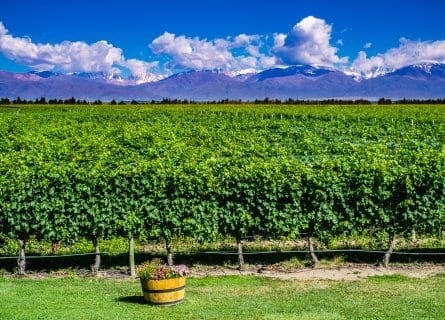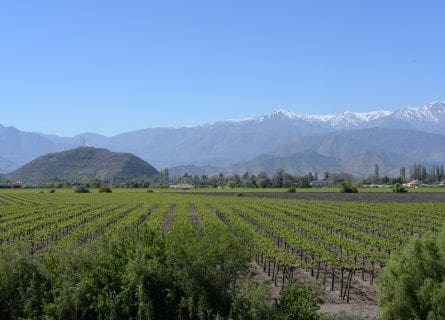Valle Central
From Santiago to Maule, a Symphony of Exquisite Reds and Elegant Whites
EXPLORE ALL OUR GUIDES TO CHILE'S WINE REGIONS
Last updated: April 10, 2024
Introduction
This substantial region houses some of Chile’s oldest vineyards and includes the capital, Santiago, to the north. The suburbs of Santiago touch the vineyards of Maipo, the northernmost of the region’s subzones. The valley runs an impressive 400km from north to south, taking in the sub-regions of Rapel, Maule, and Curico. Maipo is split into three areas: Alto Maipo, Central Maipo, and Coastal Maipo. The Andes mountains are the main element that influences grape growing in Alto Maipo. They provide an important water source for irrigation. Central Maipo has a terroir suited to red varieties: warm but not hot growing conditions, alluvial soils, and a dry climate. Coastal fogs, which drift a long way inland, help to moderate the Maipo climate; the vineyards of Coastal Maipo are found in the vicinity of the Maipo River, again a region producing mainly red wine. The wines are, on the whole, better than ever, showing ripe and vibrant fruit and great aging potential. The best reds from Maipo have traditionally been Cabernet Sauvignon, but Rhone varieties are becoming more widespread.
Winemaking and regional classifications
Rapel is a relative newcomer to the Valle Central viticultural scene but has shown great potential for fine wine production. In particular, the classic Bordeaux varieties of Cabernet Sauvignon and Merlot seem to like the Rapel climate. Further south, the warmer region of Colchagua is known for its rich, ripe reds, including Chile’s signature variety, Carmenere. In contrast, Cachapoal is becoming renowned for its success with early ripening varieties, including Chardonnay, Sauvignon Blanc, and Pinot Noir. This could be Chile’s Burgundy, judging from the wines emanating from here in recent years!
Curico is something of a chameleon, easily adaptable and able to turn out fine red and whites quickly—a region with a proud history. Over 30 varieties of wine grapes are grown today, and wine growing is the primary industry. The area’s modern history began in the 1970s with Spanish producer Torres. They quickly saw the region’s great potential and kick-started the trends of foreign investment into Chile’s vineyards; their wines are some of the best produced in Curico today. Wine Growers benefit from large mid-season temperature fluctuations, helping retain good acidity in the balance. The best examples are fruit-rich yet have wonderful balance and poise.
Last but by no means least, we arrive at Maule, one of Chile’s oldest wine regions. Long ignored by the country’s winemakers, Maule is at least now receiving the attention it deserves. White grape varieties traditionally dominated it, but today, the reds excel. Merlot, in particular, has been very successful in recent years.
South of the Central Valley, we find the Region del Sur, which includes the sub-regions of Itata and, immediately to the south, Bío Bío. As you might imagine, being the most southerly of the grape-growing regions, the climate is cool and rather wet! Winemakers in this area have been experimenting with Chardonnay and Pinot Noir, often with good results. Alsace varieties like Riesling have also shown some potential. The best wines undoubtedly come from Bío Bío.
Further Reading: Discover More Related Blog Content
More information
If you would like us to customize an exclusive luxury tour, contact us and let us know your travel plans. We offer luxury food and wine tours for private groups of a mininium two guests. In addition, all of our private, chauffeured tours are available year-round upon request.




